Green Desert: Pikmin Bloom and Nature
By gamer_152 6 Comments

If you're reading this, chances are you've spent a lot of time talking about video games on the internet. I'm not judging. But if you have spent a lot of time talking about video games on the internet, you've probably seen Nintendo compared to Disney more than a few times. Like old Walt's entertainment juggernaut, Nintendo assembles high gloss media to charm the whole family. Both Nintendo's and Disney's creations shine with upbeat icons like Mickey Mouse and Mario, liberated adventurers like Link and Peter Pan, and warm, squishy companions like Dumbo and Kirby. Both companies also set these mascots against a backdrop of western folk stories, be they existing fables, as in the cases of Frozen or The Little Mermaid, or original stories inspired by fantasy tropes, such as The Legend of Zelda or Fire Emblem. But the comparison has its limits because, for all the comforting and homey corners of Nintendo's catalogue, it's spent far more time rambling through the strange and experimental than Disney ever would.
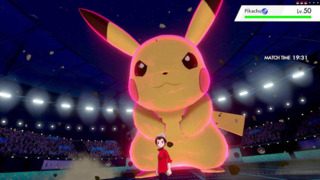
Super Mario is a famous target for surrealist analysis, with its otherverse of flying turtles, mushrooms that double your size, and teleporting plumbing. But you could also see Pokémon as an exercise in breaking reality: it's blending the line between pet and warrior and introducing outlandish animals like a mouse that shoots lightning and an elephant that can hypnotise you to sleep. But if we want really potent Nintendo bizarreness, we need look no further than Pikmin. The Earth, seen on a small enough scale, appears as an alien planet, and this sci-fi strategy romp takes advantage of that.
Most games that want to exaggerate the scale of their environment drag the camera down to the protagonist's level, allowing the surroundings to tower over you. Pikmin takes the opposite tact, hoisting the camera far above the action but still rendering monsters and treasure enormous. It creates the impression that the protagonist and their cohorts are tiny compared to the player rather than everything else just being huge. Many of Nintendo's definitive masterpieces take us back to childhood memories. For Mario, it's watching classic films and cartoons and letting our minds wander. With The Legend of Zelda, it's running around the forest imagining we're heroes on an epic quest. Pikmin feels like an eight-year-old venturing into their garden with a magnifying glass and a mason jar, ready to see what discarded food containers or creepy crawlies they can dig up today. And things get weird down there.
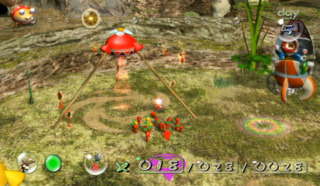
Termite queens lay an egg every three seconds for twenty years, flatworms can regrow any part of their body, Ecballium is a plant that disperses seeds through fluid-propelled rockets. Pikmin perfectly captures this biology of the uncanny and the extreme. The Pikmin themselves are ant-like in their strength and, similar to many hive insects, organise into well-trained troupes. But more peculiar, they don't fit neatly into the boxes of either flora or fauna. These organisms are bipedal humanoids but grow in the ground with leaves and petals sprouting from their heads. There's a similar weirdness in the rest of the game's zoology. The Burrowing Snagrets combine the features of eels and long-billed birds. The Wollywogs can hover in mid-air and bodyslam their prey to death. Make no mistake; death is part of Pikmin.
There are games with menageries of cute creatures and games in which legions of characters get slaughtered, but not a lot of overlap between the two. In Pikmin, the eponymous critters can fell animals much larger than them but also run the risk of being burned, drowned, munched, or otherwise meeting with a gruesome fate. Nintendo is not squeamish about depicting predation and lethal self-defence as part of nature. Preventing us from becoming detached observers of this ecological cycle are our player characters. In the series' freshman entry, Captain Olimar wrangles the Pikmin to recover the pieces of his mangled rocket and make the ride home. In the two sequels, astronauts from Olimar's home of Hocotate return to the planet in a Pikmin-led smash and grab of Earth's valuables. Although, Hocotate's idea of valuables isn't jewels and gold, it's loose bolts and lost pencil sharpeners. The strongest implications that the Pikmin homeworld is Earth are made through branded products like Skippy peanut butter and Duracell batteries.
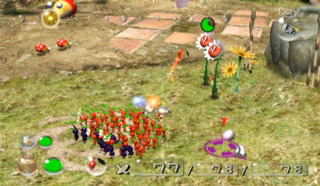
With our protagonists having the same size, shape, and vulnerability as the Pikmin, it's easy to feel a connection with our allies. That link becomes physical as we must pluck the creatures fresh from the ground and throw them to higher places or over hazards. Each colour of these animals is well speciated from the next, with the game giving them a distinct character and function within its systems. Blue Pikmin can breathe in water, Yellow Pikmin fly higher when you toss them, etc. The designers also capture how the physiology of an organism determines its interactions with the world, and therefore, its methods of survival. Blue Pikmin can breathe in water because of their gills, Yellow Pikmin are aerodynamic because of their wing-like ears, and so on.
After the success of three mainline games, Pikmin Bloom slipped these plant-tipped sapiens into players' pockets. Developed by Niantic, Bloom is an augmented reality game in the style of Ingress or Pokémon Go. Given that Ingress and Go wrote the book on developing AR mobile titles, Bloom becomes not just an adaptation of the original Pikmin but also recombines two or three different games into one. Yet, to recast Pikmin as a mixed reality experience is a dubious plan for a couple of reasons.
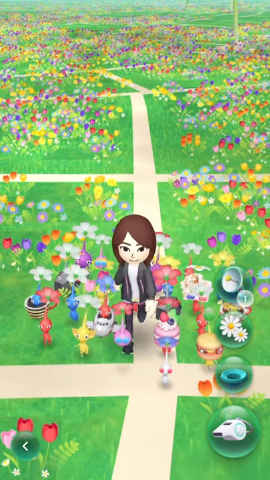
Firstly, because our real body serves as the in-game avatar in this format, entries in the genre must take place at the human scale. What's more, all games in this field place a high value on moving around our environments. The base Pikmin was about stopping to smell the roses and wading into the ponds so small we might never notice them in the real world, but Bloom would seem to have us blast past those little curiosities to bump up our step counts. Secondly, Pikmin's setting was always fascinating because its nature was alien, but Bloom is trying to anchor a Pikmin game in the universe of the familiar. You're most likely using it to explore areas of the planet you already know inside and out through the perspective you know. But okay, maybe Bloom can put us in touch with larger natural phenomena in a way that its predecessors can't. Or maybe it has a very different idea about how to tap into the microscopic. To some degree, both those speculations come to pass.
Where Pikmin 1-3 frequently set us to hunting, Bloom has us doing more gathering. And where the former titles allocated us the task of clearing rubbish from the face of our world, this mobile adventure has us placing pretty things into it. In Bloom, we can send Pikmin out to retrieve seedlings and fruit. Fruit turns into nectar, while seedlings grow into new Pikmin. If we feed Pikmin nectar, they produce petals, and we can plant petals as we walk, earning coins or rushing along the growing process for new seedlings. We can further spend coins in the in-game store.
I feel like a floral superhero, walking streets and paths while leaving trails of camellias and plum blossoms in my wake. And players can see each others' horticultural handiwork on the map. It's an enchanting representation of the communal efforts of the app's audience. You cannot, as Bloom's store page advertises, "blanket the world in flowers", as any that take root disappear after a few days. Initially, I found that impermanence disappointing but grew to accept that it let me enjoy the sights in the moment. It's not sticking around forever that makes plants pleasing; it's how they strike us in the here and now. By having these organisms fade, the game can also touch on the senescence of life, which the original games didn't. Nothing dies of old age in Pikmin 1, 2, or 3.
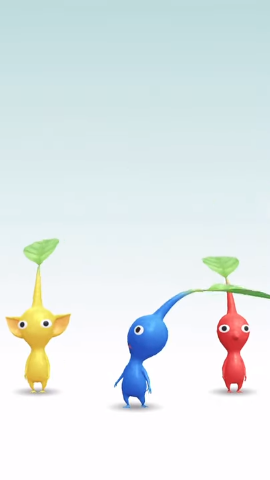
Yet, more often, Bloom feels at odds with nature, whereas the core series was pretty concordant with it. Some inconsistencies emerge from Bloom's developers retrofitting staples of the AR genre onto characters not designed to accommodate them. Let's compare this title to Pokémon Go. In Go, it makes some sense that we put eggs in an incubator and walk with them to hatch them. Anyone can carry an egg around, and they respond to body warmth and maybe even a rocking motion. It makes a lot less sense that in Pikmin Bloom, we plant seedlings inside a backpack and haul that bag around until they sprout. The defining feature of plants is that you can't move them; they're planted.
Or take the game's attempts to make individual Pikmin into your buddies. As you feed your workforce and have them perform errands, your "friendship level" with them increases. The stronger your bond with a Pikmin, the more competent at tasks they become, and if you can max out your friendship with one, they'll decorate themselves based on where you found their seedling. A Pikmin that germinated by a bakery will make a skirt out of a baguette slice, one you collected from near a body of water will don a fishing lure. But you can't have the capacity to form a relationship with an individual unless that character appears as an individual, separated from anyone else, with their own unique attributes to love.
In Pikmin Bloom, your colourful company's found costumes demonstrate their adaptation to the suburban or urban environment you're playing in. It's the kind of touch the game needs more of. However, most players won't be able to emotionally invest in one Pikmin as intensely as they can in one Pokémon. In mainline Pokémon, you switch one beast in at a time, and in Pokémon Go, you stroll about with a single buddy. Therefore, one character gets your full attention. And those characters appear as individuals because Pokémon has hundreds of unique species, and each member of a species has specific stats and powers. Maybe your Lapras can surf, but your pal's can't. Or one of your Trubbishes has a higher defence than another. Notice also that Pokémon are effectively immortal. Pikmin, by comparison, were created to be disposable and interchangeable creatures that move as a collective force.
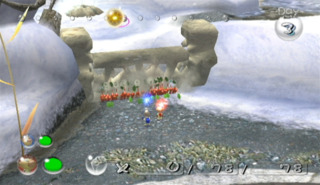
In Pikmin classic, you will see these critters die, but you need more of them to overcome challenges. So, the game has to let you replace them with identical copies. And if you're going to be commanding one hundred troops, you have to be able to reduce them to common physiologies and patterns of behaviour rather than trying to micro-manage one hundred complex characters. So, the Pikmin emerge as much more simplified and indistinct characters than Pokémon do. If you're intended to think of a Pokémon like your pet cat, you're meant to think of the Pikmin like you're a queen bee, and they're your drones. It's not conducive to one-on-one friendships.
In addition, Pikmin Bloom is missing the extraordinary variety of animals and physical phenomena that made its console counterparts come alive. For my first week or two with the app, I was let down by the absence of any life to reach out and touch beyond the Pikmin and flowers. To my excitement, I discovered at level 15 that I could send my botanical workforce out on "Challenges", in which they'd go toe-to-toe with some prey and return with the spoils. For my first challenge, I had my Pikmin tear apart a huge, colourful mushroom, and I enjoyed seeing my army work as a unit. However, it felt a little like whaling on a lifeless dummy, and I was eager to graduate to hunting wildlife with a little more bite in it. But my second challenge was a mushroom, and the third, and fourth, and soon it dawned on me that it was going to be mushrooms all the way down.
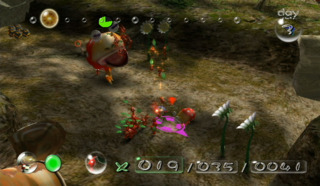
Bloom's narrow biodiversity does a disservice to the broad extravaganza of lifeforms on Earth and means that its Pikmin species are given too little stage to act out who they are. Remember, in the console games, we discovered how each colour Pikmin was threaded into a rural tapestry by employing their unique survival mechanisms. The proof of Red Pikmins' fire resistance was in seeing them encounter fire spouts and draconian monsters and emerge from the other side uncharred. You got a graphic demonstration of the weight of the Purple Pikmin when you hucked them onto flying beasts and watched them drop like anvils.
But there are no aerial animals or geothermal disturbances in Bloom, so how different can a Purple and Red Pikmin be? Some breeds can fetch items quicker than others, but this trait is not exclusive to any one type of Pikmin. Pikmin destroy fungi the same colour as them faster than they rip apart any other colour of fungus. However, that means every one of these animals is effectively a tweak on the same skill template. This poverty of obstacles for your Pikmin to overcome further constitutes a shortage of meaningful labour to undertake. That's not just a problem in itself but also degrades the sentimental value of the remaining jobs and the resources those tasks produce.
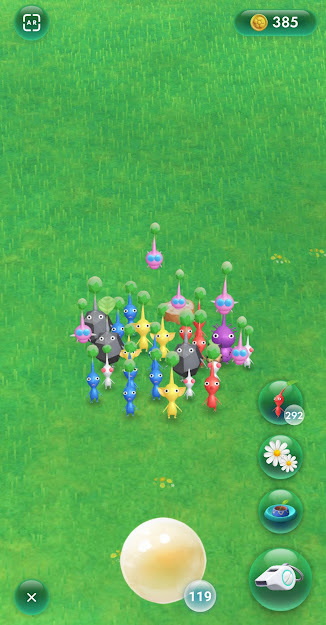
When we care about items and currencies in games, it's because we can apply them to processes that have practical benefits. The tasks that create those resources then become enticing because they produce those items and currencies. In Maplestory, we care about defeating monsters because we earn gold from doing so. We care about collecting gold because we can use it to buy equipment, which we're invested in as it lets us more efficiently attack monsters. In Raft, we might value cutting down trees because it produces wood which we in turn value because it allows us to expand our vessel.
In Bloom, your overall level isn't tied to the strength of your Pikmin, and once you have a handsome stock of each colour, there's minimal advantage to collecting more. What could I get done with 201 minions that I can't get done with 200? If I don't need more drones, there's no good reason for me to go out of my way to collect seedlings. Petals are also easy to come by, so why would I bust my hump to scavenge fruit? Where the original Pikmin manages to make junk into treasure, Bloom turns its ostensible treasure into junk. I see my neighbourhood teeming with fruits and kernels, and instead of brimming with anticipation at the sight, they just look like noise on the map to me.
It would be tempting to describe Bloom as a Pikmin-themed fitness app, and you can certainly use it as one, but what it really is is something more problematic. It's a delightfully animated pedometer with about one-third of a computer game dragging behind it. It's neither sufficiently minimalist to be criticised as an exercise companion nor fully-featured enough to provide rich interactions with non-human life, fictional or otherwise.
In Pikmin 1-3, we see nature as a brutal colosseum where only the fittest lifeforms survive. Yet, at the same time, we can appreciate how weird and wonderful that life is and develop a kinship with the animals that aid us. Like a little kid excitedly running back into their house with a new discovery, we're also encouraged to take even incidental objects discarded in the dirt like strawberries and marbles as beguiling trinkets. Bloom agrees with those titles that nature can be cute but depicts it as a gentle and more serene domain. Maybe a bit too serene because where the original games see an Earthly paradise bursting with biological pageantry, Bloom paints our planet as somewhere thin on notable zoological activity and where meaningful interactions with life are few and far between. You can make a fleeting mark on this planet, but you're marking a barren wasteland. Thanks for reading.